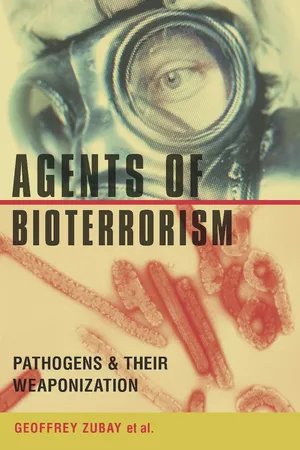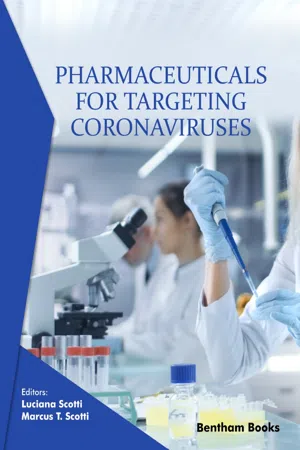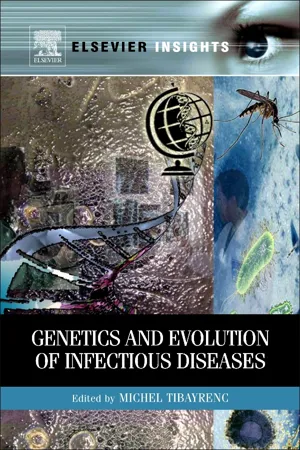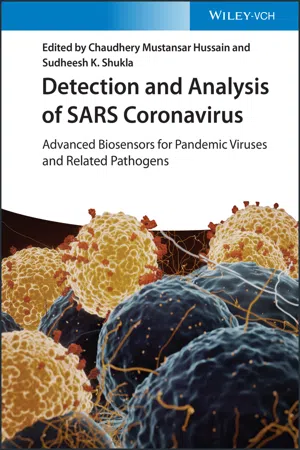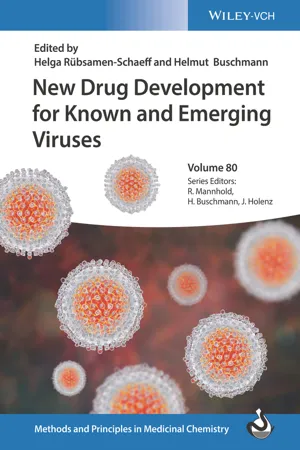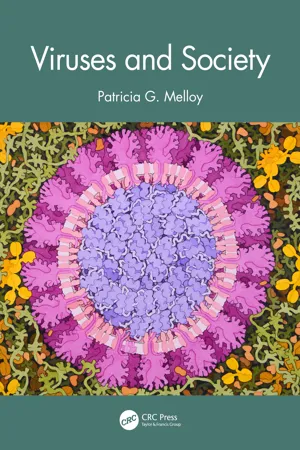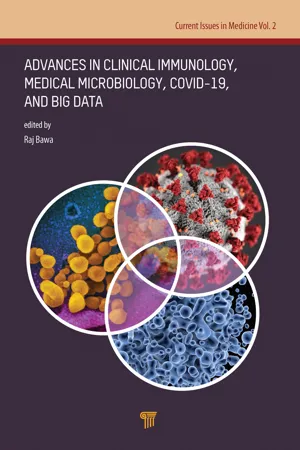Biological Sciences
SARS Virus
The SARS virus, or severe acute respiratory syndrome coronavirus, is a type of coronavirus that caused a global outbreak in 2002-2003. It is characterized by flu-like symptoms and can lead to severe respiratory illness. SARS is transmitted through close contact with infected individuals and can spread rapidly, making it a significant public health concern.
Written by Perlego with AI-assistance
Related key terms
11 Key excerpts on "SARS Virus"
- eBook - ePub
Agents of Bioterrorism
Pathogens and Their Weaponization
- Geoffrey Zubay(Author)
- 2008(Publication Date)
- Columbia University Press(Publisher)
CHAPTER 9 SEVERE ACUTE RESPIRATORY SYNDROME (SARS) Joseph Patrick Ward and Maria E. Garrido A s of early 2003, people thought that a new virus spreading throughout the world faster than the Internet could happen only in bad dreams or modern science-fiction movies. Then we learned about SARS-CoV, the virus that causes severe acute respiratory syndrome (SARS). Less than 7 months after it was first reported, SARS had taken the lives of approximately 800 people and infected a total of more than 8400 people worldwide. SARS-CoV belongs to the family of coronaviruses. The coronaviruses (order Nidovirales, family Coronaviridae, genus Coronavirus) are members of a family of large, enveloped, positive-sense, single-stranded RNA viruses that replicate in the cytoplasm of host cells. Coronaviruses are highly species-specific, and the family had only included two human-infecting viruses prior to the discovery of SARS-CoV. Coronaviruses are divided into three groups, and exactly where SARS-CoV fits into the three groups has been debated. It has even been suggested that SARS-CoV represents a new, fourth group of coronaviruses. No vaccine or effective treatment currently exists for SARS. 11 The natural host has not yet been identified despite widespread speculation that the host is the civet, a cat-like mammal from which a virus similar to SARS-CoV has been isolated. Because of the circumstances surrounding the SARS outbreak of 2003 and the very small number of cases that have been reported since, it has been proposed that the 2003 outbreak was strictly a one-time event. Although much research was conducted during and immediately after the 2003 outbreak, little research has been done on the disease and its causative agent in the latter half of 2004 - eBook - ePub
- Luciana Scotti, Marcus T. Scotti(Authors)
- 2001(Publication Date)
- Bentham Science Publishers(Publisher)
1. INTRODUCTIONCoronaviruses (CoVs) are RNA viruses that cause respiratory and enteric diseases with variable pathogenicity in humans and animals. All CoVs are known to infect humans are zoonotic, or of animal origin, and many believe they originate from host bats [1 , 2 ]. Due to the large size of the genome (the largest non-segmented RNA viral genome), single-stranded and positive sense of about 26–32 kb in size, frequent recombination and high genomic plasticity, CoVs are prone to transmission between species and are able to adapt quickly to new hosts [2 , 3 ].Severe acute respiratory syndrome (SARS), which emerged as a pandemic in 2002 and 2003, was caused by Severe acute respiratory syndrome coronavirus (SARS-CoV), a virus previously unknown [4 , 5 ]. This virus was first isolated in 2003 from samples from three SARS patients. According to the World Health Organization (WHO), SARS has infected more than 8,000 people and caused at least 813 deaths [6 , 7 ].SARS-CoV has been identified as a clinical entity in which patients have a fever, dry cough, dyspnoea, headache and hypoxemia. Typical laboratory findings are lymphopenia and slightly elevated aminotransferase levels. Death can result from progressive respiratory failure due to alveolar damage caused by an infectious agent transmitted from human to human [8 ].The pathological features available for SARS-CoV infections were mainly obtained at autopsies. The predominant visceral macroscopic were changes in fatal cases of SARS - CoV mainly in edematous lungs with increased gross weight and multiple areas of congestion, increased lymph nodes in the pulmonary hiluses and in the abdominal cavity, as well as decreased spleen size and reduced spleen weight [9 , 10 - eBook - ePub
- Michel Tibayrenc(Author)
- 2010(Publication Date)
- Elsevier(Publisher)
27. Evolution of SARS Coronavirus and the Relevance of Modern Molecular EpidemiologyZhengli Shi1 * and Lin-Fa Wang2
1 State Key Laboratory of Virology, Wuhan Institute of Virology, Chinese Academy of Sciences (CAS), Wuhan, China2 CSIRO Livestock Industries, Australian Animal Health Laboratory, Geelong, Australia* E-mail: [email protected]Severe acute respiratory syndrome (SARS) is the first major zoonotic infectious disease of the twenty-first century. The disease, originally termed “atypical pneumonia,” was first recognized in November 2002 in Guangdong Province, China, which spread rapidly to 26 countries within 5 months and eventually led to 8096 human infection cases and 774 deaths. A previously unrecognized coronavirus, SARS coronavirus (SARS-CoV), was later identified as the causative agent of the SARS. Subsequent investigation indicated that the source of the human infections was most likely originated from infected wildlife animals traded in the live animal markets, with masked palm civets being considered the most prominent and important carrier. Large-scale culling of civets appeared to have prevented further outbreaks in the region. Further epidemiological studies showed that civets are intermediate hosts of SARS-CoV, and bats are the likely natural reservoir of SARS-CoV and a large number of SARS-like coronaviruses (SL-CoVs). Detailed analysis of the massive SARS-CoV genomic sequence data accumulated indicated that SARS-CoV experienced a strong selection pressure during different outbreak phases in humans as well as interspecies transmission from animals to humans. The spike glycoprotein (S) of SARS-CoV plays a key role in virus–host interaction and hence is a key determinant of interspecies transmission. It has been shown that minor changes of amino acid (aa) residues in the S protein could lead to dramatic changes in virus susceptibility in animal and human hosts. This chapter will focus on the genetics and evolution of SARS-CoVs and SL-CoVs in humans, civets, and bats. The events of SARS outbreaks and the accompanying response activities highlight the importance of modern molecular epidemiology in disease investigation and the urgent need to broaden the screening and investigation of unknown viruses in wildlife animals. - eBook - ePub
Detection and Analysis of SARS Coronavirus
Advanced Biosensors for Pandemic Viruses and Related Pathogens
- Chaudhery Mustansar Hussain, Sudheesh K. Shukla, Chaudhery Mustansar Hussain, Sudheesh K. Shukla(Authors)
- 2021(Publication Date)
- Wiley-VCH(Publisher)
11 ]. The causes of the two major outbreaks belong to CoVs including SARS‐CoV (epidemic in 2002) and MERS‐CoV (epidemic since 2012). The latest outbreak of β‐CoVs subfamily has been carried out by SARS‐CoV‐2 since December 2019. WHO is concerned about the high‐risk health systems as there is no specific vaccine to treat SARS‐CoV‐2.The three‐dimensional structure of SARS‐CoV‐2.Figure 7.1Symptoms of SARS‐CoV‐2 include fever, loss of air, cough, sputum production, headache, cold, and, in severe cases, severe respiratory problems including respiratory insufficiency and associated comorbidities [12] . The risk factors for severe illness include age and underlying medical comorbidities such as diabetes, chronic respiratory disease, and cardiovascular disease [13] . As there is no specific vaccine or drugs are not yet available for COVID‐19, early diagnosis and management are crucial for the outbreak. CoVs cause upper respiratory tract illness in both humans and animals.The infected individuals were diagnosed by real‐time (RT ) reverse transcription polymerase chain reaction (RT‐PCR ). As the number of infected individuals increased day by day, it led to shortage of laboratory‐based testing capacity and reagents. Thus, rapid and easy‐to‐use devices are in need for the detection of infection. Early identification and detection of CoV‐infected patients and prevention of transmission of the SARS‐CoV‐2 outbreak are critical. The much need of the hour is its diagnosis. In view of this, the present chapter describes the developments in the fabrication of sensing devices, biosensors, chemical sensors, and electrochemical sensors for the detection and identification of SARS‐CoV‐2.A biosensor is an analytical device that converts biological reactions or interactions into measurable signals. The device consists of a biological component (bioreceptor) and a physiochemical detector (transducer). The biological materials, viz., enzymes, tissues, antibodies, microorganisms, cell receptors, etc., are immobilized on a physicochemical transducer and allowed to interact with the target analyte, producing useful measurable signals that may be electrochemical, optical, thermometric, or piezoelectric [14] . Depending on the interaction of the target molecule to be detected, different types of bioreceptors used ligands such as nucleic acids, biomimetic materials, antibodies/antigens, etc. Biosensors have found advanced applications in medical diagnostics and pharmaceutical, food, environmental, agriculture, and many other industries. Biosensors give more sensitive, specific, and reproducible results. Biosensors have been increasingly applied in clinical assays because of their portability and point‐of‐care testing. These biosensors can detect the target analyte in very low quantities and are considered to be a powerful tool to diagnose diseases at initial stage [15] - eBook - ePub
COVID-19 and SARS-CoV-2
The Science and Clinical Application of Conventional and Complementary Treatments
- Srijan Goswami, Chiranjeeb Dey, Srijan Goswami, Chiranjeeb Dey(Authors)
- 2022(Publication Date)
- CRC Press(Publisher)
SARS-CoV-2 is the causative organism for COVID-19. This correlation between the pathogen (in this case, the virus itself) and the disease (COVID-19) is based on the concept of the germ theory of disease introduced by Sir Louis Pasteur. According to this theory, diseases are caused by germs (or microorganisms). If this concept holds, then the obvious way to cure COVID-19 is to kill or eliminate the causative organism SARS-CoV-2. It is important to understand that it is not possible to kill viruses because they are neither living nor dead. The unique feature of viruses is that they only start functioning as living organisms when they infect a host cell. The general mechanisms of action of viruses are similar to the functioning of USB memory devices. For understanding the relationship between viruses and host cells, we will be using USB memory devices as an example. USB devices (like pen drives) are portable plug-in devices that can be attached to the USB port of a computer. Portable memory devices contain memory but they lack an operating system of their own, which means even if they have certain information stored in them, autonomous functioning is not possible. The program or information stored in the memory stick can only be transferred to the computer if the memory stick is connected to a computer (having a proper operating system) through the USB port (the receptor). The information or program stored in the memory stick becomes functional when it interacts with the operating system of the computer, present within the system. Viruses are comparable to memory sticks. Viruses are neither living nor do they have functional metabolism when present outside host cells. It is a capsule containing the information to overrule and control the genetics and metabolism of host cells. So, viruses, in general, can be thought of as invisible memory sticks existing in nature and one of these memory sticks has the ability to plug itself into a host cell that has the appropriate receptors. Following attachment with the appropriate receptor on the host cell, the information present inside the virus is passed into the host cell just like how files are transferred from memory sticks into a computer. The metabolic functions of the host cell are then taken over by viral genetic machinery which reprograms it accordingly to produce more virus particles. The gathering of newly synthesized viral particles inside the host cells after being replicated results in the spread of virus particles into the system which ultimately leads to cell death. These newly synthesized virus particles then infect other host cells and continue their lifecycle. This process goes on like a domino effect (Lipton, 2020; Dutta et al., 2021).Tracing the Origin of nCoV-19
Severe acute respiratory syndrome coronavirus 2 (SARS-CoV-2) belongs to the coronavirus family as it has remarkable similarity with the SARS Virus, the virus that caused severe acute respiratory syndrome in 2002 (WHO, 2020: 36). Several studies have confirmed that the SARS Virus of 2002 first originated in bats (initial host) where it mutated and achieved the ability to infect other hosts (intermediate host). Naturally, coronaviruses are benign but they might gain the ability to cause severe diseases in humans if they undergo appropriate mutations in primary and intermediate hosts. After severe acute respiratory syndrome caused by the SARS Virus in 2002 and Middle East respiratory syndrome by the MERS virus in 2012, in 2019, SARS-CoV-2, a member of the same family, first mutated inside bats (primary host), then jumped to an intermediate host (the actual source of the intermediate host is still under investigation), and it further mutated and gained the ability to infect human beings, causing COVID-19 (WHO, 2020). Several studies have revealed that viruses (including coronaviruses) possess the tendency to undergo periodic mutations which provides them with the ability to cross the species barrier. This phenomenon is known as a zoonotic spillover event, a term used to indicate the situation when a virus overcomes the naturally occurring barriers necessary to “spillover” from one species to another. An accurate prediction of a viral-spill timeframe is not easy as it involves multiple factors (Figure 1.4 - eBook - ePub
Pathogenic Coronaviruses of Humans and Animals
SARS, MERS, COVID-19, and Animal Coronaviruses with Zoonotic Potential
- Lisa A. Beltz(Author)
- 2022(Publication Date)
- Academic Press(Publisher)
Intervirol . 2016;59:163–169.86. Lee N, Hui D, Wu A, et al. Major outbreak of severe acute respiratory syndrome in Hong Kong . N Engl J Med . 2003;348(20):1986–1994.87. Booth SM, Matukas LM, Tomlinson GA, et al. Clinical features and short-term outcomes of 144 patients with SARS in the greater Toronto area . J Am Med Soc . 2003;289(21):2801–2809.88. Hung ECW, Chim SSC, Chan PKS, et al. Detection of SARS coronavirus RNA in the cerebrospinal fluid of a patient with severe acute respiratory syndrome . Clin Chem . 2003;49(12):2108–2109.89. Dube M, Le Coupanec A, Wong AHM, Rini JM, Desforges M, Talbot PJ. Axonal transport enables neuron-to-neuron propagation of human coronavirus . J Virol . 2018;92(17):e00404–18.90. Netland J, Meyerholz DK, Moore S, Cassell M, Perlman S. Severe acute respiratory syndrome coronavirus infection causes neuronal death in the absence of encephalitis in mice transgenic for human ACE2 . J Virol . 2008;82(15):7264–7275.91. Le Coupanec A, Desforges M, Meessen-Pinard M, et al. Cleavage of a neuroinvasive human respiratory virus spike glycoprotein by proprotein convertases modulates neurovirulence and virus spread within the central nervous system . PLoS Pathog . 2015;11:e1005261.92. Gu J, Gong E, Zhang B, et al. Multiple organ infection and the pathogenesis of SARS . J Exp Med . 2005;202(3):415–424.93. Xu J, Zhong S, Liu J, et al. Detection of severe acute respiratory syndrome coronavirus in the brain: potential role of the chemokine MIG in pathogenesis . Clin Infect Dis . 2005;41(8):1089–1096.94. Desforges M, Le Coupanec A, Dubeau P, et al. Human coronaviruses and other respiratory viruses: underestimated opportunistic pathogens of the central nervous system? . Viruses . 2019;12(1):14.95. Jacomy H, St-Jean JR, Brison E, Marceau G, Desforges M, Talbot PJ. Mutations in the spike glycoprotein of human coronavirus OC43 modulate disease in BALB/c mice from encephalitis to flaccid paralysis and demyelination . J Neurovirol - Helga Rübsamen-Schaeff, Helmut Buschmann, Raimund Mannhold, Jörg Holenz, Helga Rübsamen-Schaeff, Helmut Buschmann(Authors)
- 2021(Publication Date)
- Wiley-VCH(Publisher)
17 A Focus on Severe Acute Respiratory Syndrome (SARS) Coronavirus (SARS-CoVs) 1 and 2 Rolando Cannalire1 Enzo Tramontano2 and Vincenzo Summa1 1 Department of Pharmacy, University of Napoli “Federico II”, Napoli, Italy 2 Department of Life and Environmental Sciences, University of Cagliari, Cagliari, Italy17.1 Overview on Coronavirus (CoV)
17.1.1 CoV Epidemiology
Coronaviruses (CoVs) are pleomorphic, large, enveloped, positive-sense single-stranded RNA ((+)ssRNA) viruses belonging to the order Nidovirales, family Coronaviridae, subfamily Coronavirinae, classified into four genera: α-, β-, γ-, and δ-CoVs . CoVs are globally distributed in a large number of species including bats, camels, pigs, bovines, felines, poultry, mice, dogs, rabbits, whales, humans, and many others. The α - and β-CoVs infect only mammals, while γ- and δ-CoVs infect birds, even if some of them may also infect mammals [1] . The ~30 kb RNA genome of CoV contains at least six open reading frames (ORFs, see later for details), with an overall 54% identity at the whole genome level. However, each virus lineage can be distinguished by its ORF structure.The 5′ genomic region encodes the first ORFs, making about two-thirds of the whole genome length and scoding 16 nonstructural proteins (nsps) (nsp1–16), except γ- CoVs that lacks nsp1, and is mostly conserved with a 58% nsps identity. Differently, the 3′ genomic region varies among genera, and even from strain to strain within a viral group, with a 43% identity on the structural protein-coding region [2 , 3 ]. CoVs encode four main structural proteins: the spike surface glycoprotein (S) protein, the nucleocapsid (N) protein, the membrane (M) protein, and the envelope (E) protein. While most CoVs require all of them for a mature virion, some do not, indicating that some structural proteins might be dispensable, and their functions can be taken over by additional proteins [4]- No longer available |Learn more
- Nicole Saphier, M.D., Nicole Saphier(Authors)
- 2021(Publication Date)
- Broadside e-books(Publisher)
In a democratic system of governance such as ours, we are influenced by consensus in the form of majority rule. When it comes to science, we crave consensus in evidence-based medicine, because it confers legitimacy and provides a way to shut down minority opinions, which include superstitions and outlandish speculations. But science that challenges the consensus in responsible ways, while it may be unpopular, can be vital to advancement.So how do we distinguish false rumors from unpopular opinions that might have some measure of the truth? We follow the evidence. Start at the beginning. How did this pandemic commence? A basic question that still has not been answered.CORONAVIRIDAE: A HISTORY OF DEADLY CORONAVIRUSES
Coronaviridae is a big family of different types of coronavirus.The name “corona” comes from the crown-like appearance of S “spike” proteins on the surface of the virus itself. The most common human coronavirus (CoV) causes the “common cold,” first identified in 1965 when Tyrrell and Bynoe cultured a virus from the respiratory tract of an adult. Other, less commonly known types mostly infect animals, including bats, camels, and cattle.As our knowledge of virology and pathogenicity has grown over the last century, nothing has been more predictable than the emergence of new diseases. Since 2003, at least five new human coronaviruses have been identified. In the last two decades alone, prior to 2020, we have had two major outbreaks from them: Severe Acute Respiratory Syndrome (SARS) and Middle East Respiratory Syndrome (MERS).Beginning in 2002, SARS swept through China before it was identified in early 2003 and proceeded to spread to 28 other countries. More than 8,000 people were infected by July of that year, and 774 died.Testing people with symptoms, isolating suspected cases, and restricting travel all likely contributed to the halt of the SARS epidemic. Curiously, data from seroepidemiologic studies conducted among food market workers in areas where the SARS epidemic presumably began showed that 40 percent of wild animal traders and 20 percent of individuals who worked with them were seropositive for SARS, meaning they had been exposed to the virus, although none had a history of having SARS-like illness. These findings suggest that many undiagnosed individuals were exposed through their occupation to a SARS-like virus. It also implies that exposure frequently caused asymptomatic infection (or infection subclinical enough to go unnoticed), yet this finding did not garner much attention as the outbreak was contained quickly. - eBook - ePub
- Patricia G. Melloy(Author)
- 2022(Publication Date)
- CRC Press(Publisher)
6 SARS-CoV-2 and COVID-19DOI: 10.1201/9781003172260-6Learning Outcomes:
- 6.1 Describe the Details of Novel Coronavirus (SARS-CoV-2) Compared to Other Viruses
- 6.2 Understand How SARS-CoV-2 Is Transmitted among Humans, Discover How SARS-CoV-2 Affects the Body, and Understand What Tests and Treatments Are Available
- 6.3 Examine the Historical Factors Leading to the Development and Continuation of the COVID-19 Pandemic
- 6.4 Follow the Race to Develop a COVID-19 Vaccine
- 6.5 Differentiate the Course of the Pandemic before and after Mass Vaccination Campaigns Begin in the United States
- 6.6 Discuss Whether the COVID-19 Pandemic Could Have Been Prevented and What the World Learned from the COVID-19 Pandemic
- 6.7 Recognize the Impact of the COVID-19 Pandemic on the United States and the World, and What Our Societies Will Look Like Post-Pandemic
In this book, we have discussed epidemics and pandemics, many of which took place before humans even knew what viruses were. Now, in the 21st century, we have more research tools and techniques, medicines, and types of health interventions than ever, yet the COVID-19 pandemic still made life difficult for almost every human being on the planet, even those who did not acquire the virus. What is SARS-CoV-2, and how did it create the COVID-19 pandemic unchecked? What are the current treatments for COVID-19 and how did researchers develop a vaccine so fast? How has our society forever changed during the COVID-19 pandemic? We will explore these questions and other details in this chapter.6.1 Describe the Details of Novel Coronavirus (SARS-CoV-2) Compared to Other Viruses
Coronaviruses are a family of large single-stranded RNA viruses (Class IV Baltimore classification) with a lipid envelope covering studded with spike proteins, thus giving the virus the crown-like appearance behind its name (corona means crown in several languages going back to Latin and Greek) (Figure 6.1 ). These spike proteins help the virus attach to our cells, in particular cells that display the ACE2 receptor (Christakis 2020 ; Baltimore 1971 ; Rabadan 2021 ; Wright 2021 ; Callaway 2020 ; Cyranoski 2020 ). Cells in the lungs, digestive tract, and brain all have ACE2 receptors, in addition to endothelial cells, the cells that line blood vessels (Wright 2021; Cyranoski 2020). The viral particle itself is about 100–125 nanometers in diameter (Rabadan 2021; Cyranoski 2020; Bar-On et al. 2020 ). Once the coronavirus attaches to cells, it enters through our own cellular trafficking network and is processed in a specialized structure known as an endosome. Then the viral genome (RNA-based) is released so the viral proteins can be translated using the host’s own machinery. A viral enzyme also makes a negative strand (template) copy of the RNA genome, so that the coronavirus subgenome can be transcribed and translated to make the proteins needed for the new virion particles. Once the subgenome is copied and new viral proteins are made, the virus assembled in the cytoplasm buds out as a membrane-bound virion using the ER and Golgi, and then makes it way to the plasma membrane to be released from the cell (LabXchange 2021a ; Cyranoski 2020; Callaway 2020; Ackermann, Berthiaume, and Tremblay 1998 ). When compared to other viral pathogens, SARS-CoV-2 is said to have a lower mutation rate than influenza A, and it can proofread its RNA genome to fix errors. However, it has a fast rate of replication once in a host cell (Abdelrahman, Li, and Wang 2020 - Raj Bawa, Raj Bawa(Authors)
- 2021(Publication Date)
- Jenny Stanford Publishing(Publisher)
In addition to influenza pandemics, coronaviruses have also caused regional epidemics prior to the current COVID-19 pandemic (Figs. 1.1–1.4). Coronaviruses of zoonotic origin have caused large-scale cluster outbreaks of severe respiratory disease. These include the Severe Acute Respiratory Syndrome Coronavirus (SARS-CoV) epidemic in 2003 in mainland China and the Middle East Respiratory Syndrome Coronavirus (MERS-CoV) epidemic in 2012 in Saudi Arabia and in 2015 in South Korea. SARS-CoV (the first coronavirus) spread to 26 countries before the outbreak was contained with over 8,000 people infected and a case fatality rate of approximately 10%. Regarding MERS-CoV, infections are still occurring and have been reported in almost 30 countries. While human-to-human transmission for MERS-CoV is rare, some studies show the case fatality rate to be greater than 30%.The year 2020 will forever be marked by the presence of the Severe Acute Respiratory Syndrome Coronavirus 2 (SARS-CoV-2)3 and the associated COVID-19 pandemic. COVID-19 has had a catastrophic effect on the world’s demographics resulting in ~3.76 million deaths so far. After the first cases of this predominantly respiratory viral illness were “officially” reported by the Chinese government in late December 2019, SARS-CoV-2 rapidly circumvented the globe in a matter of weeks, compelling the World Health Organization (WHO) to declare it as a global pandemic on March 11, 2020. As of June 8, 2021, globally, there have been 174,591,505 coronavirus cases and 3,757,419 deaths, and 157,941,391 patients have recovered from COVID-19.4 Virtually overnight, this pandemic profoundly altered the world as it struggled to contain the coronavirus while mitigating its health, economic and social impact. For a global pandemic to occur, the following requirements are needed: emergence of a new human microbe; reduced or minimal population immunity to that microbe; and a relatively simple mode of transmission. SARS-CoV-2 fulfills all three of these criteria.3 It is important to distinguish the SARS-CoV-2 virus from the disease it causes, namely, COVID-19. In this chapter, I will use the terms SARS-CoV-2 virus, CoV-2 virus, and coronavirus 2 interchangeably to refer to the virus that causes COVID-19.4 Worldometer. COVID-19 outbreak live update. Available at: https://www.worldometers.info/coronavirus (accessed on June 8, 2021). Another authoritative source is the Johns Hopkins Coronavirus Resource Center: https://coronavirus.jhu.edu/- eBook - ePub
- N. Brender(Author)
- 2014(Publication Date)
- Palgrave Macmillan(Publisher)
Hazard identification included identification of the risk source or causative agent and the assessment of the cause-effect relationship. At first, very little epidemiological information was available. A severe respiratory disease could cause death quickly, and occurrences of nosocomial transmission and household transmission seemed to imply that prolonged contact was necessary to transmit the disease. Risk tracking, including laboratory research and testing, was performed in order to identify possible sources for the disease and points of origin. When Hong Kong reported two human cases of avian influenza, WHO activated in response to this new fact its global influenza laboratory network to perform tests about the disease. Based on the laboratory tests results, the suspicion of a form of influenza, including an H5N1 avian influenza, was replaced by the presumption of an unknown severe respiratory disease designated as an “atypical pneumonia.” Analyses in China were negative about influenza. Later in the process, anthrax, pulmonary plague, leptospirosis, and hemorrhagic fever were also eliminated as possible causes of the disease. The fact that patients did not react to antibiotics caused investigators to think that the causal agent could be a virus, and this track was further investigated until the novel coronavirus was discovered.Finding the cause of the disease (in this case, a new coronavirus) and obtaining enough evidence that this virus caused SARS were the primary tasks of the virology network. The identification of the causative agent was essential in preventing further international spread and developing emergency plans. (53 p. 1730) First, such identification could result in the production of diagnostic tests to facilitate the early identification, isolation, and treatment of patients, without researchers’ having to rely exclusively on case definitions. Second, it would allow a better clinical management of patients with the use or development of adequate drugs. Third, and on a longer time horizon, it could lead to the development of a vaccine. Finally, virology discoveries would also help epidemiologists enhance their understanding of the origin of the disease, its incubation period, its infection rate, and its transmission patterns. A further step would be to discover where this virus came from. Although research determined that particular animals were a reservoir of the virus, as of today, it has not been shown whether the virus is animal or human in origin. Progress toward identifying the virus was the result of the collaborative work of different partners in the virology network (Germany, Singapore, Hong Kong, the Netherlands, and the United States) that further built knowledge based on the findings of their colleagues. (53
Index pages curate the most relevant extracts from our library of academic textbooks. They’ve been created using an in-house natural language model (NLM), each adding context and meaning to key research topics.
